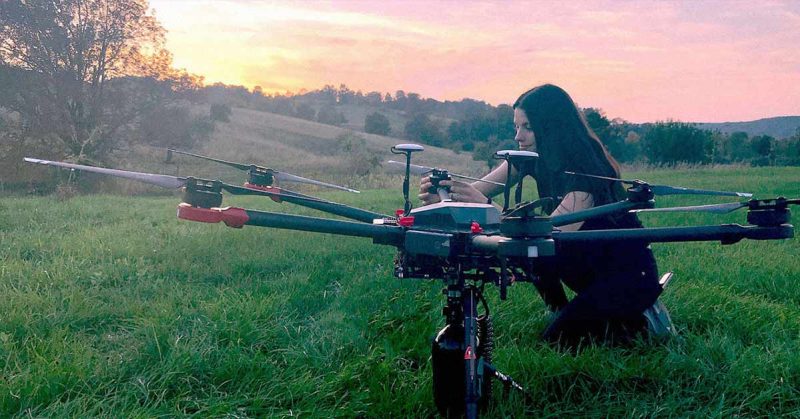Drones for tree-planting have been a popular concept for a few years now. [1] These drones are high-powered, well-advanced machines and as such, they can work tirelessly to plant hundreds of thousands of trees in record time. As with many other technological inventions deployed in these modern times, these devices have faced major criticism for replacing human labor and livelihoods. However, in some areas of the world, forest loss and land aridity constitute such massive problems that technological intervention may be the only solution for restoration.
One such innovational company is Flash Forest, a Canadian startup using drones to plant thousands of native pine and spruce trees on acres of land north of Toronto. [2] They are working on areas that have been devastated by wildfires, firing tens of thousands of seeds from their drones into the soil. They aim to plant 1 billion trees by 2028 to restore habitats for birds and increase biodiversity across the country.
Tree planting for forest restoration is one of the most efficient ways humans can control global warming – it’s the fastest and cheapest natural method of absorbing carbon from the atmosphere. According to the International Panel on Climate Change (IPCC), we need to plant at least 1 billion hectares of trees within the next thirty years to limit global warming to a manageable 1.5 degrees Celsius. [3] Otherwise, our planet may progressively be rendered inhabitable.
While the company believes the results would be more encouraging if existing trees are protected, their drones would serve in the meantime to restore what has already been lost. “There are a lot of different attempts to tackle reforestation,” says Flash Forest co-founder and chief strategy officer, Angelique Ahlstrom. “But despite all of them, they’re still failing, with a net loss of 7 billion trees every year.”
How the drones work

Flash Forest begins their work on a site by mapping out the areas where the drones would be firing into using aerial mapping software. According to the company, they designed their machines with a pneumatic firing system to get into “trickier areas that human planters can’t.”
Next, they prepare the seed pods using about four to eight varieties and species. The pods are also designed to retain moisture so they’d be certain to germinate and thrive in drier months. They are also prepared using a proprietary mix to speed-up the sprouting time.

“We very much prioritize biodiversity, so we try to plant species that are native to the land as opposed to monocultures,” says Ahlstrom. “We work with local seed banks and also take into account that the different changes that climate change brings with temperature rise, anticipating what the climate will be like in five to eight years when these trees are much older and have grown to a more mature stage, and how that will affect them.”
While a human can plant estimably 1,500 trees a day, each one of Flash Forest’s drones can plant 10,000 to 20,000 pods per day. They are hoping that in the future, their technology would plant at least 100,000 trees a day. It’s a known fact that not all the seeds will germinate. However, the company plants such high numbers of seeds daily to increase the number of potential survivors — especially without regulate human checkups.
“Depending on the project, we’ll go back two months after, and then a year or two after, and then three to five years after to make sure the trees are actually sequestering as much carbon as they planned,” Ahlstrom explained. “If we fall under a threshold plant goal of a certain number of trees, we’ll go back and ensure that we are hitting our goal.”
Big ambitions

When we are told trees have the “mind-blowing potential” to save the world and eliminate the climate change crisis, it’s all really based on simple biology. Trees give off oxygen (what we need) and absorb carbon dioxide (part of what is damaging our planet). However, tree planting efforts are somehow being rendered less significant than intended as deforestation rates continued to increase. [4] Older trees store more carbon and when they are cut down, years of carbon absorption are reversed and the gas is released back in tons to the atmosphere.
“If we plant 20 million trees, the earth will get with 260 million more tons of oxygen. One acre of trees can remove up to 2.6 tons of Carbon Dioxide each year.”
Since its inception in 2019, Flash Forest has run several tests with the drone prototypes, subsequently recording high survival rates of the seeds. They are currently working in British Columbia and Toronto, and they plan to hit Hawaii later this year to plant at least 300,000 trees. They are funded by government contracts, forest companies, and donations.
“There’s a lot of philanthropy around it, and then also just a solid business model with a desperate need and demand to plant trees,” Ahlstrom says.
Well, while the technology is certainly innovative with great potential, we don’t have to wait for drones to come around before we plant trees in our surroundings. Trees are medicinal to the environment and in reality, they are very easy to plant and require little maintenance – a great pastime for any time of the year!
References
- “These tree planting drones are about to start an entire forest from the sky.” Fast Company. Adele Peters. Retrieved June 9, 2020.
- “These drones will plant 40,000 trees a month. By 2028, they’ll have planted 1 billion.” Fast Company. Adele Peters. Retrieved June 9, 2020.
- ” Key climate panel, citing impending crisis, urges crash effort to reduce emissions.” Science Mag. Dennis Normile. Retrieved June 9, 2020.
- “CLIMATE 101: DEFORESTATION.” National Geographic. Christina Nunez. Retrieved June 9, 2020.
- “Our Mission: Automate.” Flash Forest.
- “Tree planting ‘has mind-blowing potential’ to tackle climate crisis.” The Guardian. Damian Carrington. Retrieved June 9, 2020.


